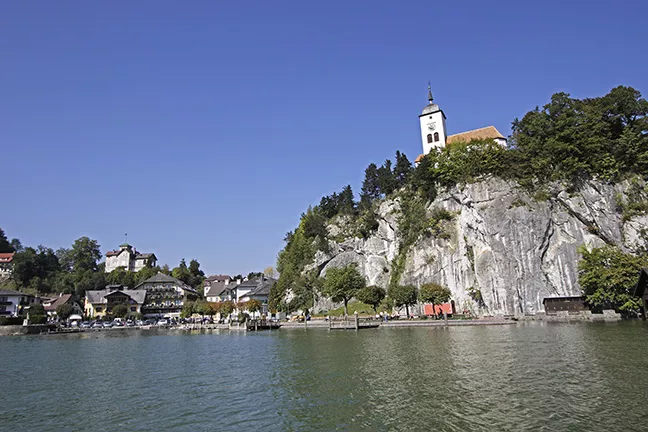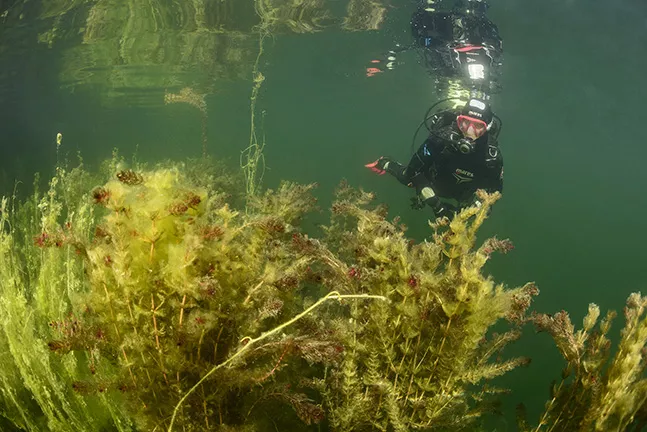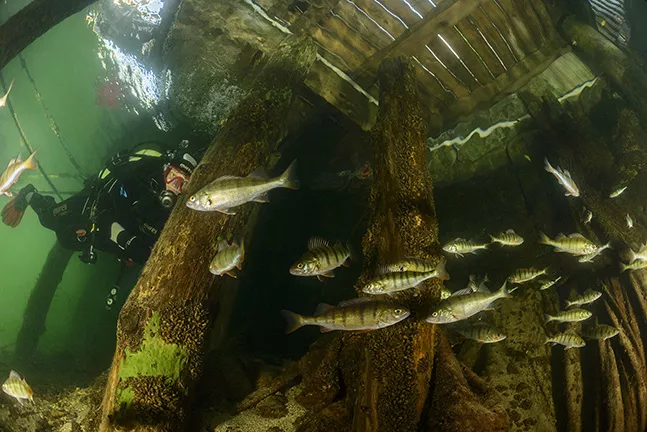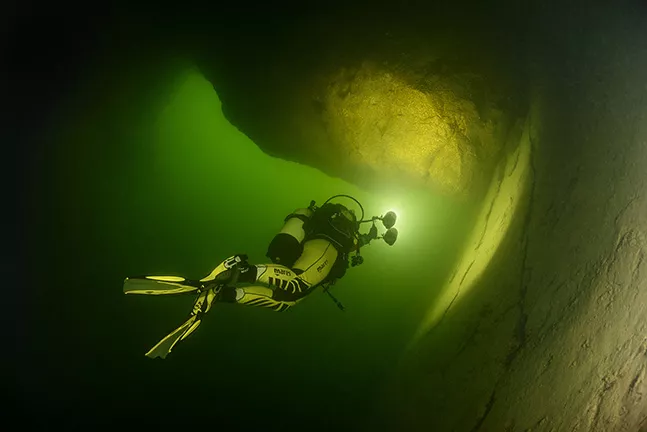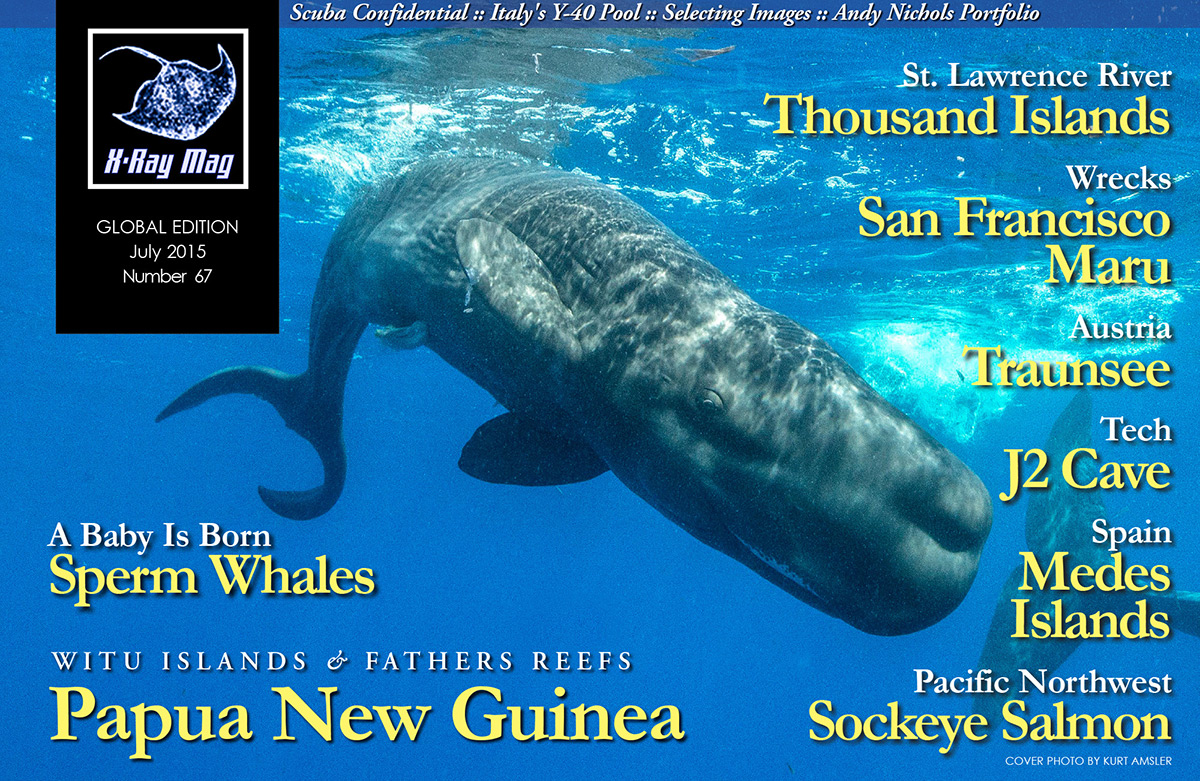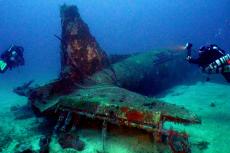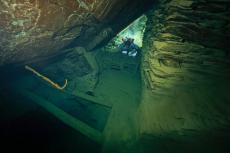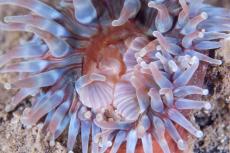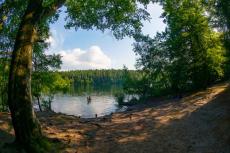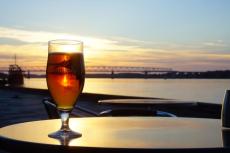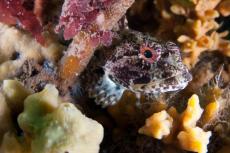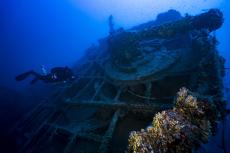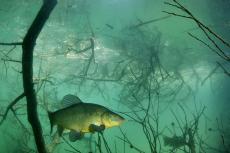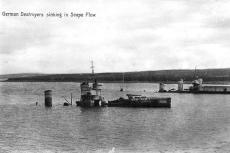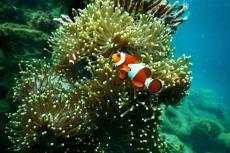While Traunsee is mostly known for its endless sloping rock faces, the deepest lake in Austria has much more to offer. Caves, archways, wrecks and fish-rich shallow waters make it an all-rounder as Wolfgang Pölzer explains in this introduction to one of his favorite haunts.
Contributed by
Factfile
Wolfgang Pölzer is a widely published underwater photographer and dive writer based in Austria.
See: www.underwater-photos.net.
For more information on Traunsee, see the guide book, Tauchreiseführer Austria by Wolfgang Pölzer and Barbara Lackner (ISBN: 3-900323-73-9), which can be purchased for 20 Euros (~US$23) at www.taucherland.at.
If ever there was a dive location worth mentioning, with a house reef in a lake far from the ocean, it would be the one found in Austria’s Salzkammergut region—more precisely, in the picturesque town of Traunkirchen, on the west shore of Traunsee (Lake Traun).
Here, we find the pretty spa hotel, Das Traunsee, with a dive shop operated by Jochen Kern. In this prime location, Kern has been running a small but excellent dive center for over 14 years. It’s got a cosy atmosphere in which a massive wooden table has been set up to make it easy to prepare dive equipment and kit up just by the entry point, making freshwater diving fun and easy.
Diving
The greenish waters are unexpectedly warm as our party descended, following the gently sloping bottom consisting mostly of gravel. Keeping to the right we came to some lush meadows covered with aquatic plants. Following a set line, we reached our first stage at 13m, a training platform. The remains of an old VW bus sat nearby in the sediment like some sort of artificial reef. At least that is what I could make out from the outline of it, as it was completely encrusted by zebra mussels.
Originally from Eastern Europe, these mussels—which are only about three centimeters long—seem to have found a heaven of their own in Traunsee. There is nowhere else in Austria where these molluscs are present in such big numbers. Every solid piece of surface seemed to have become a substrate for a booming population of these small filter feeders.
Indeed, the mussels are upsetting the original biological balance, but this situation comes with some advantages for divers. The many millions of small mussels act as a natural sewage treatment plant by continually filtering nutrients and particles from the water. In turn the visibility is significantly improved, at least until the next heavy rainfall washes a renewed load of nutrients into the lake and the cycle starts all over.
In fact, the VW bus being totally encrusted in a layer of clam shells makes for a great photographic subject. And if one continues to head left of the bus, there is an increasingly steep slope that soon ends in a vertical rock wall where the small mollusks are densely clustered—only interspersed by yellow-brown patches of freshwater sponges, which incidentally, are also filter feeders.
Crisscrossed with cracks and small overhangs, the drop-off ended in a plateau at a more sport-diving-friendly 30m range. Visibility improved and was a good five meters better than at the surface. Despite the depth, a lamp was not required to see.
As if we were taking an elevator, we slowly floated back up over five floors to the warmth in sunlit shallow water. Here we came across a boat wreck, and in between the sunken trees, a rich community of fish seemed to thrive. We spotted several pike hiding among the branches and dense schools of perch swimming in open water. The best chance to get close to them would have been directly from beneath the jetties of the hotel.
After a dive of 94 minutes, we headed to the surface again; it was such a varied dive that time just flew by. And we hadn’t even been to the Monastery Meadow dive site —a shallow plant-rich patch of water full of fish. “That’s a good excuse for a night dive,” said Kern. “It is a right soup of fish and I guarantee there is eel.”
Diving by speedboat
After a delicious lunch on the hotel terrace, enjoying a romantic view of the lake, we took a speedboat out to our next dive.
It so happens that the vast majority of dive sites of Traunsee are not accessible from land, such as the bluffs that run for kilometers on the east coast. Interspersed by big boulders, steep, rugged drop-offs plunge vertically into the lake and continue down to a depth of 100m, making it a paradise for underwater hunters and technical divers.
Bat Bay. In matter of a few minutes by speedboat, we crossed the Traunsee and stopped in front of an imposing rock face, which rose up in front of us. Bat Bay is the promising name of this dive site. “Hold on tight to your camera and lamp,” warned Kern, “because what is lost here will be gone forever. There is more than 100m to the bottom. Focus on your entry, do a last check and descend.”
I kid you not, the wall along which we were now descending was absolutely vertical, as it slid past us on our way down. At 20m, we halted our descent and swam to the right. Once more, the surfaces were covered with dense mats of zebra mussels, which reach out a few millimeters into the open water to catch plankton. Aside from the mussels, there was no other life in sight.
After traversing some more rock for a few minutes, the rock face suddenly stopped, and we stared down a huge abyss that opened up before us. Somewhat hesitantly, we floated into the darkness. Only when our eyes adjusted to the dim light did we realize that we were floating through a giant archway. Or more precisely, we were in a vertical canyon in which a 20m-wide boulder was jammed into the crevasse right over our heads. Looking back towards the open water, it was a highly unusual sight to behold on a freshwater dive.
“I’ve got a good dozen more similarly spectacular diving spots to show you” Kern exclaimed, as we returned to the boat. “For example, just recently we discovered a snow-white steep wall that drops off vertically from 10 to 60m and has a surface that is smooth as silk—it is just awesome,” said Kern. We took his word for it and promised to come back.
About the lake
Traunsee offers fascinating and very varied dives, with the most beautiful cliffs in the country, as well as fish-rich shallow waters. It is worthwhile visiting Traunsee any time of year, even in winter, as the lake never quite freezes over, making it unsuitable for ice diving. With its altitude of over 400m, it is considered a mountain lake—so make sure your dive computer goes into altitude mode.
Traunsee is not only the deepest lake in the country, but next to the neighboring Attersee, it is also the second largest lake of Austria. The elongated, trough-shaped basin is longitudinally traversed from south to north of the Traun. This explains its high susceptibility to bad visibility after long rains or snowmelt.
Another feature is a stable saltwater layer in very great depths (160-170m) at the bottom of the lake. This feature connects the meromictic nature (a term meaning it has layers of water that do not intermix) of Traunsee, so the lake’s body of water is never completely circulated. The layer of salty water is a result of more than 400 years of salt production in Ebensee during which time calcium chloride was let out into the lake.
During summer, a visibility of five to 10m can be expected, but during autumn and winter, it can occasionally be double that distance. However, snowmelt and prolonged rainfall can reduce visibility to very modest values.
Among the highlights, in addition to countless spectacular cliffs, are the many fish and plant species in shallow waters. There is a myriad of bass and pike as well as rudd, trout, eel, chub and carp. In some places, large freshwater sponges can be seen, not to mention, the ubiquitous zebra mussels.
Dive operator
Since 2000 Jochen Kern has managed a SSI-affiliated dive shop in conjunction with the famous lakeside hotel, Das Traunsee, located in the picturesque village of Traunkirchen. Set in a prime location directly on the lake, the center not only has an extremely diverse reef right outside, but its quick dive boat can easily bring up to six divers to any of the 16 other dive sites on the east and west shores within minutes.
The shop offers SSI certification, and on request, PADI courses from Open Water Diver to Instructor Assistant. Children need to be a minimim 10 years of age. Tech training is offered up to the level of SSI Normoxic Trimix diver. Also, more recently, courses in sidemount diving are offered. A small number of sets of sports diving equipment is available for rental. The center is open daily from 9:00 AM to 5:00 PM from early July to mid-September, and in June from Thursday to Sunday only. During off-season and winter, the dive center is only open on weekends and by request. For more information and rates, see: www.tauchschule-traunsee.at. There is another dive shop on the eastern shore in Gmunden. See: www.tauchschule-neptun.at.
Regulations and fees
The Traunsee can be dived for free at any time without a diving permit. However, there are zones where a diving ban exists, which include the spacious Gmundner Bay (culture zone), the areas around the Monastery of Traunkirchen and south to the end of the village as well as the area around the piers for liner shipping. The dive card, which is 15 Euros (~US$17) per year, is not mandatory at the Traunsee, however, it is recommended and serves the maintenance of free diving at many lakes in Austria.
With an additional fee of 5 Euros (~US$6), you can buy a permit to use toilets and hot showers in the hotel as well as changing facilities and free drinking water or tea at the base, in addition to the great infrastructure around the lake (to purchase this permit, go to the website: www.arge-tauchen.at).
Accommodations
The most convenient and safe choice of accommodation is the four-star spa hotel Das Traunsee in the town of Traunkirchen. In the hotel is the dive center, with optimal access to the lake. Comfortable, double rooms are available. For rates, see: www.dastraunsee.at.
Landhotel Post is a much cheaper choice. It is a three-star hotel in the neighboring village of Ebensee. Double rooms are available at the 70-room hotel. For rates, see: www.hotel-post-ebensee.at.
Camping Traunsee is yet a cheaper option. It is a small campsite in the neighboring town of Altmünster. For more information and rates, see: www.camping-traunsee.at.
Topside excursions
Traunsee is surrounded by the beautiful mountains of Höllengebirge where the two mountain peaks of Feuerkogel (1,592m) (www.feuerkogel.net) and Traunstein (1,691m) meet. Mountain bikers and hikers come here as well as paragliding or climbing enthusiasts. For those who prefer to stay at sea level, there is the famous Gmunden Ceramics, the Schlosshotel Orth and a lake cruise on the Gisela—Europe’s oldest paddle steamer, which is not to be missed! See: www.traunseeschifffahrt.at. ■


